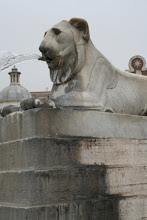
 When Axel Munthe wrote The Story of San Michele in 1929 it was a best seller, running into countless editions. Born in Sweden, Munthe became a medical doctor in his early twenties and battled cholera epidemics in Paris and Naples; subsequently he established a successful practice in Rome, treating rich and poor clients alike and almost bullying his patients into recovery. He was melancholic, passionate about human and animal rights and conducted a discreet and long-running affair with the soon-to-be Queen of Sweden from his home in Anacapri. His story of the building of the villa San Michele, including the discovery of the head of Medusa from the seabed, and his dream (and subsequent location) of the ancient Sphinx that now looks out from the belvedere of his villa is captivating.
When Axel Munthe wrote The Story of San Michele in 1929 it was a best seller, running into countless editions. Born in Sweden, Munthe became a medical doctor in his early twenties and battled cholera epidemics in Paris and Naples; subsequently he established a successful practice in Rome, treating rich and poor clients alike and almost bullying his patients into recovery. He was melancholic, passionate about human and animal rights and conducted a discreet and long-running affair with the soon-to-be Queen of Sweden from his home in Anacapri. His story of the building of the villa San Michele, including the discovery of the head of Medusa from the seabed, and his dream (and subsequent location) of the ancient Sphinx that now looks out from the belvedere of his villa is captivating.Nearly 20 years ago I visited the villa at Anacapri and it was such a memorable and emotive place for me. For years I had a watercolour of Villa San Michele above my workdesk and I still have it, although now its in our house in Fremantle. I've wanted to show Jim this place for years.
We take the winding path to San Michele passing shuttered villas behind iron gates. Most of them are in the white-painted, flat-roofed vernacular although we occasionally glimpse a maverick red or rose-pink villa. The Viale Axel Munthe curves around the villa and down to the original entrance, the 'Port of Difference' with countless steps down to the lower village of Capri.
The villa was completed by 1903. It stretches along the ridge of rock with fantastic views of the Gulf of Sorrento, and standing alongside the granite Sphinx we can see far down below to the main marina, where today's ferries dock. In an arc we can see the mainland of Naples, and the coast of Positano; we can also look east towards the ruins of Tiberius' Villa Jovis.
The loggia is a beautiful place and we wander through the rather austere rooms of the villa by way of the little enclosed courtyard. Far up above and behind the villa is Mount Barbarossa. By 1910 Munthe owned all of this land and his was the sole villa on this stretch of hillside. Now it's dotted with countless white villas, although the original terraced gardens of San Michele are still intact. There are some Australian melaleucas growing alongside daffodils and hyacinths. We are very reluctant to leave this place; such a haven and very, very beautiful.
Some consolution is the setting of our hotel, the Casa Caprile. The villa is in similar style to San Michele and was built for the crown princess Victoria of Sweden, under the supervision and advice of Axel Munthe. We circle the perimeter, looking for the original pillars topped with griffons as seen in a 1912 photograph at San Michele. With encroaching building, the approach to Casa Caprile has now changed to a side entrance. The main building is still largely unchanged however, and the interior has the same vaulted ceilings and turreted roof as originally shown.
We spend five days on the island and the weather is unvaried. It drizzles almost constantly. We have some odd dinner experiences, especially when we decide we need some real sustenance and fetch up at one of the local pizzerias that has stayed open outside the tourist season. The restaurant is stone cold, the TV is blaring and we share space with one other couple, who have wisely ordered the pizza. Our waitress has a mobile phone glued to her ear and it remains there for almost the entire evening. The wine is indescribably bad. We end up self-catering for most of our visit.
On our last full day on Anacapri we catch the local bus down into Capri and trek out to Villa Jovis, one of the 12 Roman villas built by the emperor Augustus. It's still raining and we see very few people on our way up to the ruins. When we arrive, we have the site to ourselves save for the caretaker and his three goats. The Villa Jovis has a lookout, called Tiberius' Leap, where hapless victims of the emperor were dispatched. Its a long way down to rocks below, and Tiberius supposedly had men stationed in boats to make sure any enemies who survived the fall were dealt with.
We wander the three levels of the vast complex that was built around the time of Christ. The structure still has the domed roof of the servant villas in place. At the highest level of the complex the church of Santa Maria del Soccorso has been built - a lonely place for worship. In the distance we can see the coast of Sorrento, and on the other side, the island of Ischia. It's an ideal location for visibility given that Augustus, and Tiberius, communicated with the mainland and ruled Rome by using a form of signalling involving night flares. Its easy to imagine the relative safety of ruling the roman empire from the island, compared to dangerous and insurgent Rome.

No comments:
Post a Comment